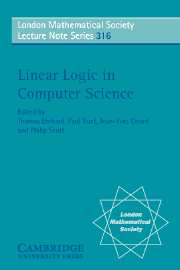Book contents
- Frontmatter
- Contents
- Preface
- List of contributors
- Part one Tutorials
- Part two Refereed Articles
- 5 An Axiomatic Approach to Structural Rules for Locative Linear Logic
- 6 An Introduction to Uniformity in Ludics
- 7 Slicing Polarized Additive Normalization
- 8 A Topological Correctness Criterion for Multiplicative Non-Commutative Logic
- Part three Invited Articles
8 - A Topological Correctness Criterion for Multiplicative Non-Commutative Logic
Published online by Cambridge University Press: 17 May 2010
- Frontmatter
- Contents
- Preface
- List of contributors
- Part one Tutorials
- Part two Refereed Articles
- 5 An Axiomatic Approach to Structural Rules for Locative Linear Logic
- 6 An Introduction to Uniformity in Ludics
- 7 Slicing Polarized Additive Normalization
- 8 A Topological Correctness Criterion for Multiplicative Non-Commutative Logic
- Part three Invited Articles
Summary
Abstract
We formulate Girard's long trip criterion for multiplicative linear logic (MLL) in a topological way, by associating a ribbon diagram to every switching, and requiring that it is homeomorphic to the disk. Then, we extend the well-known planarity criterion for multiplicative cyclic linear logic (McyLL) to multiplicative non-commutative logic (MNL) and show that the resulting planarity criterion is equivalent to Abrusci and Ruet's original long trip criterion for MNL.
Introduction
In his seminal article on linear logic, Jean-Yves Girard develops two alternative notations for proofs:
a sequential syntax where proofs are expressed as derivation trees in a sequent calculus,
a parallel syntax where proofs are expressed as bipartite graphs called proof-nets.
The proof-net notation plays the role of natural deduction in intuitionistic logic. It exhibits more of the intrinsic structure of proofs than the derivation tree notation, and is closer to denotational semantics. Typically, a derivation tree defines a unique proof-net, while a proof-net may represent several derivation trees, each derivation tree witnessing a particular order of sequentialization of the proof-net.
The parallel notation requires to separate “real proofs” (proof-nets) from “proof alikes” (called proof-structures) using a correctness criterion. Intuitively, the criterion reveals the “geometric” essence of the logic, beyond its “grammatical” presentation as a sequent calculus. In the case of MLL, the (unit-free) multiplicative fragment of (commutative) linear logic, Girard introduces a “long trip condition” which characterizes proof-nets among proof-structures. The criterion is then extended to full linear logic in.
- Type
- Chapter
- Information
- Linear Logic in Computer Science , pp. 283 - 322Publisher: Cambridge University PressPrint publication year: 2004
- 4
- Cited by

